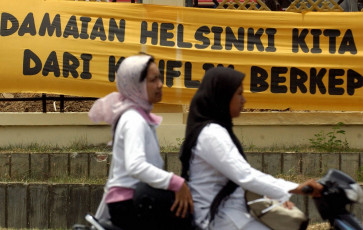Popular Reads
Top Results
Can't find what you're looking for?
View all search resultsPopular Reads
Top Results
Can't find what you're looking for?
View all search resultsLetters: Timor Leste and Kashmir
This refers to an article in The Jakarta Post Aug
Change text size
Gift Premium Articles
to Anyone

T
his refers to an article in The Jakarta Post Aug. 25 titled "Timor Leste a model for Kashmir".
It appears to be a little incongruous to compare the two situations. Kashmir was acceded to India through the Treaty of Accession, a legally valid document.
While King Hari Singh of Kashmir was still undecided about signing the treaty, Pakistan chose to send armed tribal forces to invade Kashmir.
At that point, the treaty of accession was signed in Kashmir and India sent its army to prevent further invasion. Kashmir has remained divided ever since across what is called the Line of Control between the two countries.
The act of aggression by Pakistan before the treaty was signed was a malicious act aimed at subverting the agreed process. It was India who wanted a peaceful resolution and took the matter to the UN Security Council, where a resolution was passed calling on Pakistan to withdraw the armed forces, Pakistani citizens and militant tribesmen, and then asking to hold the plebiscite to ascertain the wishes of Kashmiris. The forces were never withdrawn by Pakistan and hence, the plebiscite for a united Kashmir could not be held.
Pakistan was formed on a two-nation theory, carving out the areas with a Muslim majority from India. Unlike in India, right from the inception there was no stable government or democracy in Pakistan.
In 1971, an election in (East and West) Pakistan resulted in an overall majority for an East Pakistani party, which is ethnically mainly Bengali.
The Pakistani military refused to allow the parliament to convene. East Pakistanis demanded autonomy, then independence, in the face of brutal repression by the Pakistani military.
Guerilla warfare ensued. About 10 million refugees streamed into India from East Pakistan, at which time India took the issue to the world forum.
Pakistan attacked airfields in India and Indian-controlled Kashmir. India retaliated in West Pakistan and also intervened in the East, on the side of the Bangladeshis.
In the 14-day war that followed, Pakistan lost the war on both fronts and Bangladesh became independent. Ninety thousand Pakistani soldiers surrendered to the Indian Army in Dhaka, and Pakistan lost its entire eastern territory and a new nation - Bangladesh - was born.
It was a war lost by an aggressor nation to a defending nation, which is a seldom the case in history.
The Simla agreement was signed between India and Pakistan in 1972, according to which both sides agreed "to settle their differences by peaceful means through bilateral negotiations or by any other peaceful means mutually agreed upon between them." Both countries agreed they would not unilaterally try to alter the Line of Control in Kashmir.
This Simla agreement is the last political and diplomatic document and forms the basis for any dispute resolution with regard to Kashmir.
First, a conducive and peaceful environment needs to exist on both sides, followed by free trade between Kashmiris and the two countries and then to an open-borders situation, which will make the dispute itself irrelevant.
The model of Indonesian society is relevant to Kashmir and in the larger subcontinent. Indonesia is a showcase to the world of a peaceful, modern, progressive and tolerant society standing on the foundation of Islam.
The rest of the world would be a better place to live if they learned this from our society.









